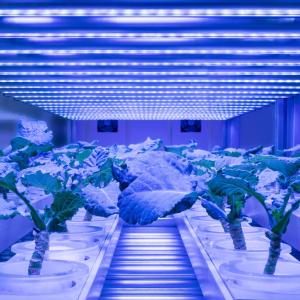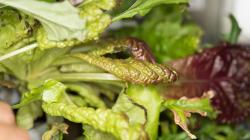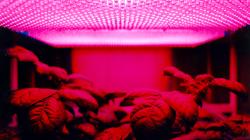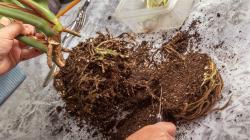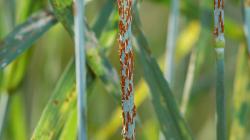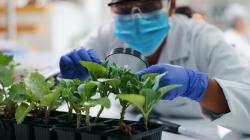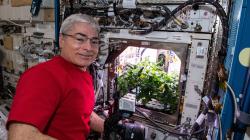'Ecosystems beyond Earth' IS ONE OF OUR NEW TEACHING SEQUENCES FOR V9
- On the 'Sequence overview' tab you'll find all the lessons in this sequence and curriculum alignment.
- The 'Our design decisions' tab shows how key scientific ideas develop over the sequence, and shows how the sequence addresses curriculum achievement standards.
- Have you taught this sequence? Use the Feedback button to let us know how it went!
Launch
Lesson 1 • Dining in space
This lesson introduces the necessity of obtaining energy through food and explores the conditions experienced by astronauts.
Inquire
Lesson 2 • Tracking energy
Students examine the challenges of comparing and measuring plant growth. They plan an experiment that examines the energy needs of a plant, using coloured light.
Lesson 3 • Matter matters in space
Students use secondary data to generate a column graph comparing the portions of different plants that are edible. They examine the recycling of matter on the International Space Station.
Lesson 4 • Space invaders (biosecurity)
Students will examine the complex nature of food webs and how they can be affected when a new species is introduced. This is then compared to the need for biodiversity and biosecurity on the ISS or space settlements.
Lesson 4A • Biosecurity testing
Students model a biosecurity measure used to detect an infectious agent on an imported product.
Act
Lesson 5 • Space farming
Students consolidate their learning by designing a pod that could be used to grow the food that is needed for the International Space Station or a space habitat.
The Australian Academy of Science supports and encourages broad use of its material. Unless indicated below, copyright material available on this website is licensed under a Creative Commons Attribution-NonCommercial-ShareAlike 4.0 International (CC BY-NC-SA 4.0) licence.
Curriculum and syllabus alignment
Achievement standards
By the end of Year 7 students represent flows of matter and energy in ecosystems and predict the effects of environmental changes. Students identify the factors that can influence development of and lead to changes in scientific knowledge. They explain how scientific responses are developed and can impact society. They explain the role of science communication in shaping viewpoints, policies and regulations.
Students plan and conduct safe, reproducible investigations to test relationships and aspects of scientific models. They identify potential ethical issues and intercultural considerations required for field locations or use of secondary data. They use equipment to generate and record data with precision. They select and construct appropriate representations to organise data and information. They process data and information and analyse it to describe patterns, trends and relationships. They identify possible sources of error in methods and identify unanswered questions in conclusions and claims. They identify evidence to support their conclusions and construct arguments to support or dispute claims. They select and use language and text features appropriately for their purpose and audience when communicating their ideas and findings.
Australian Curriculum V9 alignment
Science as a human endeavour
Science understanding
Use models, including food webs, to represent matter and energy flow in ecosystems and predict the impact of changing abiotic and biotic factors on populations
Science inquiry
develop investigable questions, reasoned predictions and hypotheses to explore scientific models, identify patterns and test relationships
plan and conduct reproducible investigations to answer questions and test hypotheses, including identifying variables and assumptions and, as appropriate, recognising and managing risks, considering ethical issues and recognising key considerations regarding heritage sites and artefacts on Country/Place
plan and conduct reproducible investigations to answer questions and test hypotheses, including identifying variables and assumptions and, as appropriate, recognising and managing risks, considering ethical issues and recognising key considerations regarding heritage sites and artefacts on Country/Place
analyse methods, conclusions and claims for assumptions, possible sources of error, conflicting evidence and unanswered questions
construct evidence-based arguments to support conclusions or evaluate claims and consider any ethical issues and cultural protocols associated with using or citing secondary data or information
write and create texts to communicate ideas, findings and arguments for specific purposes and audiences, including selection of appropriate language and text features, using digital tools as appropriate
Australian curriculum content links
| Science understanding core concept: Biological systems are interdependent and interact with each other and their environment. |
| Sub-strand | Content descriptor | AC code | Achievement standard | Elaboration/ application |
|---|---|---|---|---|
| SHE: Use and influence of science | Explain how new evidence or different perspectives can lead to changes in scientific knowledge | AC9S7H01 | Students identify the factors that can influence development of and lead to changes in scientific knowledge. | Re-examine data and evidence as new information about different plants or space travel become available (Lessons 1-5). |
| SHE: Use and influence of science | Investigate how cultural perspectives and world views influence the development of scientific knowledge | AC9S7H02 |
Different people in society have different perspectives on space travel and settlements in space (Lessons 3 and 5). | |
| SHE: Nature and development of science | Examine how proposed scientific responses to contemporary issues may impact on society and explore ethical, environmental, social and economic considerations | AC9S7H03 | Students explain how scientific responses are developed and can impact society. | Discussing how scientific knowledge of space travel that have led to numerous inventions and any ethical, environmental, social and economic implications of these changes (Lesson 5). |
SHE: Nature and development of science
| Explore the role of science communication in informing individual viewpoints and community policies and regulations | AC9S7H04 | Students explain the role of science communication in shaping viewpoints, policies and regulations. | Explaining how science communication can affect people's understanding of travel in space and the importance of biosecurity in ecosystems (Lessons 4A and 5). |
| SU: Biological sciences | Use models, including food webs, to represent matter and energy flow in ecosystems and predict the impact of changing abiotic and biotic factors on populations | AC9S7U02 | Students represent flows of matter and energy in ecosystems and predict the effects of environmental changes. | Analysing food webs to show feeding relationships between organisms in an ecosystem and the role of microorganisms (Lesson 4). Modelling how energy flows into and out of an ecosystem via pathways of food webs (Lesson 2). Examining how events such as the introduction of a species impact abiotic and biotic factors and cause changes to populations (Lesson 4). |
| SI: Questioning and predicting | Develop investigable questions, reasoned predictions and hypotheses to explore scientific models, identify patterns and test relationships | AC9S7I01 | Students plan and conduct safe, reproducible investigations to test relationships and aspects of scientific models. They identify potential ethical issues and intercultural considerations required for field locations or use of secondary data. | Discussing features of investigable and non-investigable questions related to testing how plants grow including consideration of resources available and examining their own and other questions (Lesson 2). |
| SI: Planning and conducting | Plan and conduct reproducible investigations to answer questions and test hypotheses, including identifying variables and assumptions and, as appropriate, recognising and managing risks, considering ethical issues and recognising key considerations regarding heritage sites and artefacts on Country/Place | AC9S7I02 | Compare the method for testing the effect of coloured light on plants with the hypothesis and examine the reasonableness of the method for testing that hypothesis. Discussing why it is important to identify variables and assumptions when planning an investigation (Lesson 2). | |
| SI: Planning and conducting | Select and use equipment to generate and record data with precision, using digital tools as appropriate | AC9S7I03 | Students use equipment to generate and record data with precision. | Constructing tables, spreadsheets and graphic organisers to collect data and information. Standard units and simple unit conversions (Lessons 2 and 3). |
| SI: Processing, modelling and analysing | Select and construct appropriate representations, including tables, graphs, models and mathematical relationships, to organise and process data and information | AC9S7I04 | Students select and construct appropriate representations to organise data and information. | Construct food webs energy flow and matter (Lesson 1 and 4). Using spreadsheets to analyse second-hand data (Lesson 3). Selecting appropriate data for representations (Lessons 1-5). |
| SI: Processing, modelling and analysing | Analyse data and information to describe patterns, trends and relationships and identify anomalies | AC9S7I05 | Students process data and information and analyse it to describe patterns, trends and relationships. | Identifying anomalies in data and investigating their effect on observed patterns or relationships (Lessons 2 and 4). |
| SI: Evaluating | Analyse methods, conclusions and claims for assumptions, possible sources of error, conflicting evidence and unanswered questions | AC9S7I06 | Students identify possible sources of error in methods and identify unanswered questions in conclusions and claims. | Identifying and considering indicators of the quality of the data when analysing first-hand and second-hand data. Evaluating the method used when testing the impact of colour light on plants, identifying assumptions made about variables that should be controlled and suggesting ways it could be improved. Analysing conclusions and claims to identify facts or premises that are taken for granted to be true. Identifying the evidence being cited to support a claim and evaluating conflicting evidence. (Lessons 2-5) |
SI: Evaluating
| Construct evidence-based arguments to support conclusions or evaluate claims and consider any ethical issues and cultural protocols associated with using or citing secondary data or information | AC9S7I07 | Students identify evidence to support their conclusions and construct arguments to support or dispute claims. | Constructing an argument supported by evidence and reasoning to support or reject a hypothesis. Drawing a logical conclusion in consideration of the method of data collection, quality of evidence and limitations or significance of a claim and exploring how to determine the credibility of a source (Lessons 2-5). |
| SI: Communicating | Write and create texts to communicate ideas, findings and arguments for specific purposes and audiences, including a selection of appropriate language and text features, using digital tools as appropriate | AC9S7I08 | Students select and use language and text features appropriately for their purpose and audience when communicating their ideas and findings. | Writing a science report with diagrams, graphs, and data, including examination of the accuracy and reproducibility of the data and create an informative text for a younger audience (Lesson 5). |
Teaching notes
- Read through the teaching sequence.
- Note any adaptations you would like to make to suit your schools and students’ context.
- Check that your IT department will allow access to the YouTube videos.
- Complete the ordering of laboratory equipment and rooms (if required).
- Ensure that students can access the excel data spreadsheet required for Lesson 3.
The materials required for each lesson are listed on the lesson's page. For the full sequence resource list, download the Preparing to teach this sequence document below.
Lab tech notes
As required in all states, teachers must prepare their risk assessments of the activities. Some of the risks that need to be considered are listed below.
Many students in the class may have limited food experiences which can impact their ability to develop a wider understanding of this topic.
Lesson 1
Lesson 1 has an activity that encourages students to explore foods that may be grown in a space settlement. Eating in a science laboratory is not advisable. A feasible alternative is the local school cafe or lunch area. Use common leafy products that are in season and locally available (prewashed bags of mixed lettuce are a simple alternative). Check for students' food allergies and encourage students to wash their hands before and after eating.
Lesson 2
Students design an experiment to test the effect of coloured light on the growth of plants. Use local leafy seedlings where possible. Lettuce seedlings are easy to use and can usually be purchased cheaply. Egg cartons can be divided into 12 smaller containers to hold the seedlings and help contain appropriate moisture level (this will also reduce the need for extra soil). Wooden sticks or skewers can be used to make square-based pyramids of cellophane (minimising the cellophane used and maximising seedling numbers). A double layer of each cellophane colour is important as a single layer does not always have the desired impact. Seedlings under green cellophane will initially grow taller as they try to reach more light. Students working in small groups is preferred to maximise student learning, however this activity can be done as a whole class if cost and space is a consideration.
Lesson 3
Teachers will demonstrate how to determine the edible proportion (by weight) of a plant vs inedible proportion. While a full-grown plant is preferred, a left-over seedling from the previous lesson can be appropriate.
Lesson 4A
When selecting objects for the optional biosecurity dusting, hard objects are easier to clean post-activity. Consider if the objects need to be slightly damp to encourage the bicarb soda to 'stick' during preparation so they later test 'positive' for students. This may require testing beforehand to ensure a successful result for students during the class. If the negative objects can be identified with the naked eye, consider using flour to disguise the status of all objects. Universal indicator can be highly flammable and can irritate skin and eyes. Ensure there are no naked flames, and if skin or eyes are exposed, wash the affected area with running water.
The materials required for each lesson are listed on the lesson's page. For the full sequence resource list, download the Preparing to teach this sequence document below.
